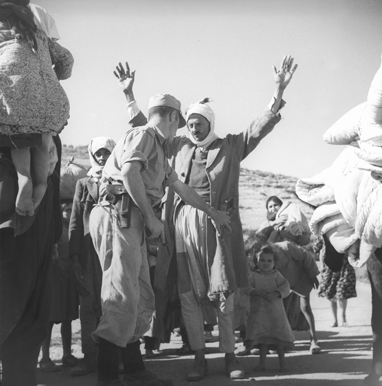From PALESTINE TO ISRAEL: A Photographic Record of Destruction & State Formation 1947-50
 Thursday, January 26, 2012 at 11:06AM
Thursday, January 26, 2012 at 11:06AM by Ariella Azoulay translated by Charles S. Kamen
Pluto Press 2011
 "Arabs Fleeing" from IDF and Defensive Archives Photographer not identified.
"Arabs Fleeing" from IDF and Defensive Archives Photographer not identified.
The events that led to the violent foundation of the Israeli state are wrapped in layers of mythology and propaganda, which are still being promoted and advocated today.
Ariella Azoulay’s fascinating book and recent exhibition at the Mosaic Rooms in west London, combines detailed research and analysis of the history and politics of the whole period that preceded the Partition of Palestine before 1947 and the succeeding years. It lifts the lid off the prevailing mythology, using photographs mainly from the Haganah archives, hidden for more than six decades, and provides a revealing new commentary on them. By its pioneering methodology of using a ‘civil imagination’ and re-interpretation, it rejects the nationalist narrative that the photographs are meant to portray to the Israeli public in concealing the unfolding disaster it created, and reconstructs the reality of the ‘Nakba’ that was caused to the Palestinians.
Until today, Israelis in general were encouraged to think of the events that happened to the Palestinians as a ‘catastrophe from their point of view’. Azoulay’s intention by revealing the truth of the events hidden by the photographs’ banal original captions, is to lift their ‘colonial aphasia’- the difficulty in generating the appropriate vocabulary to the appropriate events, concepts and things - and use the proper understanding of these events that affected both peoples, as a way to formulate a new reality that would bring about a move towards eventual reconciliation.
The UN resolution that created the partition of Palestine in 1947, designed only by the Zionist leadership and the UN, was vehemently opposed by most of the country’s Arab inhabitants of 90 percent of the land who were never consulted, and ‘not an insignificant number of Jews.’ The Palestinians were not wanted in the new state that was declared, and the Zionist leadership and its enforcers, the Haganah, were bent on erasure of the Palestinian presence and the physical evidence of their habitation, agriculture and customs. Their war crimes included the destruction of hundreds of beautiful villages and towns, including large parts of Ramle, Lydda, Jaffa, Haifa and Beersheba, reducing them to rubble, which the new Jewish immigrants from Europe helped to move, level and use as a base to rebuild new homes, if not taking over the ones that were retained, after the inhabitants were expelled.
In a typical photograph, as Azoulay comments. “the official caption that reads ‘Beit Sha’an abandoned’ doesn’t serve to display for us a town abandoned, rather than one whose inhabitants are to be returned, a town that no longer belongs to those who built it or who until yesterday lived there. It refers to the achievement that created a ‘valley that’s entirely Jewish’ “.
The author’s commentary, often in elegant, challenging and intriguing prose, that replaces the existing bland and often misleading euphemisms in the archive photographs, exquisitely captures the nightmare of the expulsions, the mood and feelings of the dispossessed, and the casual arrogance of the dispossessors. It makes one feel a witness to the events which unfold in these haunting, surrealistic tableaux. The pictures depict the corralling of the refugees behind barbed wire enclosures, the long queues directed out of emptying villages, the buses employed to move them to Jordan, Lebanon, and Gaza across newly established lines that once were open land or borders. Then followed the registering of refugees in locations they were allowed to stay but still confined to ghettoes, all these were ‘mechanisms of subordination’ and then socialization carried out with pre-planned ruthlessness.
Much of this has ironic echoes of what is still continued with the Occupation today, with the matrix of control, the identity cards, the checkpoints and the Separation Wall in the West Bank, the dispossession of the Bedouin in the Negev and the West Bank, and the house evictions and demolitions in East Jerusalem.
Azoulay describes the events between 1947 and 1950, and subsequently, as “a civil malfunction - the way citizens relate to the man-made disaster in whose continuing reproduction and preservation they participate.” This original book is an indispensable tool to unraveling the dystopia created by the Israeli state and illuminates the way to a new future of justice and hope.
-----------------------------------------------------
Ariella Azoulay directs the Photo-Lexic Project at Tel Aviv University. She is the author of a number of books on Photography including 'the Civil Contract of Photography(2008) and 'Civil Imagination: A Political Ontology of Photograohy(2012).
***********************************************************************************
 APJP | Comments Off |
APJP | Comments Off |